
This article is translated by: Da Miao

Within the coverage area of the LoRaWAN network, network capacity can be expanded by adding more gateways. A dense LoRaWAN deployment combined with optimized ADR (Adaptive Data Rate) can significantly increase network capacity while reducing power consumption and the operator’s TCO (Total Cost of Ownership) by approximately 10 times.
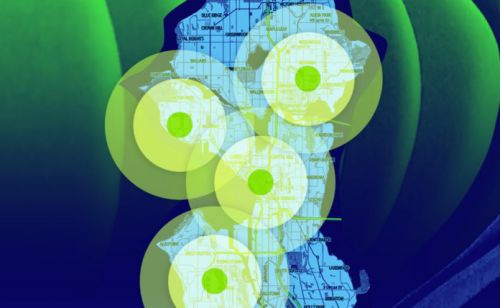
LoRaWAN has become one of the key radio technologies for solving the challenges of low-power wide-area network (LPWAN) deployments, addressing issues such as power efficiency, remote deployment, scalable deployment, and cost-effectiveness.
The LoRa Alliance has over 500 members, with heavyweight members like Google, Alibaba, and Tencent recently joining the alliance.
The first wave of LoRaWAN network deployments focused primarily on large-scale nationwide deployments led by operators such as KPN, Orange, and Swisscom. The upcoming next wave of deployments is expected to be dominated by large private enterprises, enabling interconnection between public and private networks, especially for LPWAN geolocation use cases.
In IoT use cases, operators and end customers prefer to use LoRaWAN to enable connectivity. As IoT deployments grow in density, network planning inevitably becomes one of the critical factors for ensuring long-term success and profitability for operators and end customers.
A typical example is the recent contract for 3 million water meters signed by Veolia Birdz and Orange. Such large-scale projects require comprehensive and detailed network planning to achieve the necessary density and service quality while optimizing costs.
Further Research on LoRaWAN Density Technology
The LoRaWAN network utilizes existing network spectrum, and its architecture is a star topology, making network deployment and ongoing densification straightforward: when more gateways are added to the infrastructure, frequency planning or reorganization is not required.
Compared to Mesh technology, single-hop to the network infrastructure minimizes power consumption, as nodes do not need to relay communications from other nodes. Another advantage is that, compared to Mesh, deploying the initial network in a sparse mode with low node density is feasible, requiring minimal node density to operate. More importantly, in the face of increasing interference, LoRaWAN is not affected by the exponential packet loss suffered by multi-hop RF network technologies.
Another unique feature of the LoRaWAN network is that messages in the uplink can be received by any gateway. The function of the network server is to eliminate duplicate elements in the uplink based on the uplink RSSI estimates and to select the best gateway for downlink transmission. This makes it easy to incorporate features such as geolocation into LoRaWAN deployments. It also enables uplink macro diversity, significantly improving network capacity and service quality (QoS).
LoRaWAN also supports features such as Adaptive Data Rate (ADR), which allows the network server to dynamically change terminal device parameters such as transmission power, frequency, and spreading factor through downlink MAC commands. Optimizing these settings is key to increasing terminal device capacity and reducing power consumption.
Optimizing LoRaWAN parameters and densifying the network can lead to a significant increase in network capacity. In fact, the capacity of a LoRaWAN network can almost indefinitely expand with increasing density.
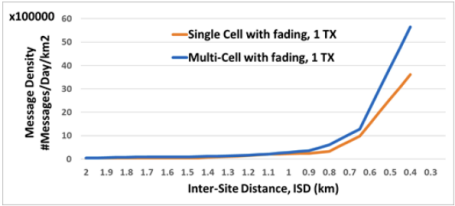
Image Source: Actility
In the future, especially in urban environments, due to increased traffic, the business volume of LoRaWAN networks is expected to grow, and its future will trend towards LPWAN.
How Densification Reduces Total Cost of Ownership for Enterprises
As more LoRaWAN gateways are deployed, the network achieves densification, and adaptive data rate (ADR) and power control algorithms can be intelligently applied within the network, significantly reducing the power consumption of terminal devices, thereby reducing the total cost of ownership (TCO) of terminal devices.
The following figures clearly indicate that densification can save up to 10 times the power consumption and reduce the overall 10-year TCO for enterprise deployments. The labor required for battery replacement is a major cost in the 10-year TCO for large-scale enterprise deployments.
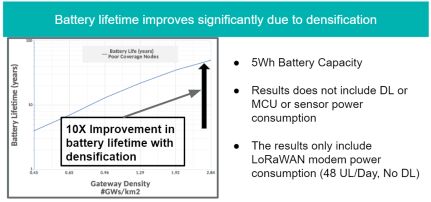
Image Source: Actility
Densification leads to a significant reduction in terminal device power consumption, thereby lowering overall TCO.
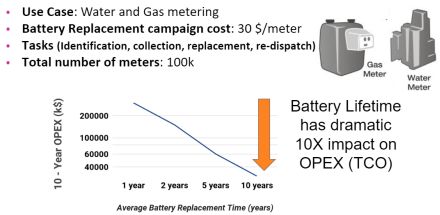
Image Source: Actility
Densification leads to a significant reduction in terminal device power consumption, thereby lowering overall TCO.
LoRaWAN is typically deployed in unlicensed spectrum, allowing anyone to launch IoT networks based on LoRaWAN. There are three network deployment models:
1. Public Operator Networks
In this traditional model, operators invest in a network covering a region or nationwide and sell connectivity services to their customers.
2. Private/Enterprise Networks
In this model, enterprise customers typically set up LoRaWAN gateways in private locations (e.g., airports). They either own gateways managed by operators or use their own LoRaWAN network platform. The second deployment model is a game changer for dense device use cases, as network capacity and enhanced QoS can slightly increase costs. This is feasible because LoRaWAN operates in unlicensed spectrum, and gateways are very inexpensive and easy to deploy.
3. Hybrid Model
This is the most interesting model for LoRaWAN deployment due to its open architecture. It is impossible (or rather difficult) to compete with other LPWAN technologies or cellular networks. This is due to the lack of roaming models between specific spectrum and public networks. There are some solutions, such as CBRS and MulteFire from 3GPP, but they are still in development and far from maturity for large-scale IoT deployments, especially for use cases requiring 10-15 years of battery life.
In the hybrid model, operators provide lightweight outdoor coverage nationwide, but different stakeholders, such as private enterprises or individuals, can reinforce the network based on their location needs, further enhancing network density. This model achieves a win-win public-private partnership that can share the costs and revenues of the network and densify the network with the most applications and devices.
This model is feasible because multiple gateways can receive LoRaWAN messages, and the network server can eliminate duplicates. For scenarios involving different operators or enterprises operating networks, the LoRa Alliance has approved the “LoRaWAN Backend Interface 1.0 Specification” for roaming architecture to enable network collaboration.
This model significantly reduces operator investment and provides a disruptive business model for establishing IoT where it is most needed.
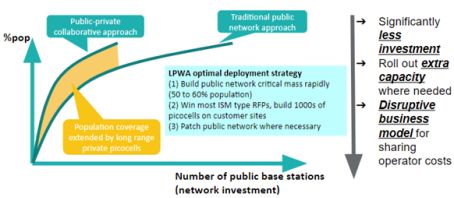
Image Source: Actility
LoRaWAN allows for public and private deployments, enabling collaborative models based on cost and revenue sharing, and densifying the network where it is most needed based on IoT application demands.
LoRaWAN Densification: Key Drivers for Reducing Operator TCO
When designing and deploying LoRaWAN networks, system operators must balance the costs of dense networks and their service sensors with the costs of sparse networks and their service sensors.
Traditional vs. Opportunistic Network Design
In the traditional network deployment model, operators deploy LoRaWAN gateways on telecom towers. This requires leasing space from tower owners, purchasing a weatherproof outdoor gateway, climbing the tower to hang the gateway, and possibly paying additional power, zoning, licensing, and backhaul fees. Operators need to conduct detailed RF propagation studies and hang enough gateways to provide adequate coverage for the sensor locations they need to serve.
Another option is to opportunistically deploy “mother” gateways within the equipment already deployed by operators. Gateways are stateless, so they do not add much complexity to the host devices. Pairing an 8-channel LoRaWAN reference design with the host device using USB or I2C allows operators to embed simple 8-channel gateways into ongoing WiFi hotspots, power supplies, amplifiers, cable modems, thermostats, virtual assistants, or any device already in mass production.
Calculating the number of opportunistic gateways in a specific area can be challenging. The height of the gateway has a significant impact on its coverage. A gateway deployed on the 20th floor has better coverage than the same gateway deployed in a basement of a single-family home. A gateway deployed on a WiFi hotspot on a power pole has a different coverage area than a gateway deployed on the same power pole. Therefore, the actual number of gateways deployed in each scenario varies greatly.
When detailed designs for each type of network are completed, it is often found that the opportunistic deployment model allows operators to deploy approximately 100 times more gateways to cover a given area at about one-tenth the cost (compared to the traditional third-party tower leasing model).
Water Meters: A Typical Use Case
For the remainder of this analysis, we will assume that operators need to deploy a LoRaWAN network to service 100K water meters. Water meters present a challenging RF propagation model. They are installed at ground level or underground, must have a 20-year lifespan, and suburban meters are often covered by grass and dirt. Let’s assume a North American deployment model where we can choose to use high-power (27dBm) or low-power (17dBm) meters.
One possible design is a tower-based approach. In a tower-based approach, operators typically deploy high-power water meters to reduce the number of expensive tower leases. To operate at high power, North American regulations require sensors to transmit over 50 channels, prompting operators to deploy 64-channel gateways.
Assuming an average distance of 3 kilometers between the water meters and the tower-based gateway, sensors need to send readings once a day. Therefore, many meters operate at 27 dBm with SF 10. Sensor designers include a high-power RF amplifier, calculate the energy requirements over the sensor’s lifetime, and size the battery accordingly.
Another possible design is to opportunistically deploy thousands of “mother” gateways in the area. The question boils down to: “How many ‘mother’ gateways do I need to cover the required area?”
In many urban environments, the average distance between a given operator and users is 30 meters. If operators can opportunistically deploy in most sites, the distance between gateways can be as small as 30 meters. For analysis, we assume the average distance between the sensor and the nearest gateway reduces from 3000 meters to 100 meters. When the sensor is 100 meters from the gateway, it can typically operate at 17dBm (or lower) at SF7. Clearly, network designers must consider the distance distribution between a given sensor and its nearest gateway, but overall, the energy savings are still significant.
Comparing the total capacity of a tower-based LoRaWAN network with that of an opportunistic LoRaWAN network is also instructive. The cost of 100 opportunistic 8-channel gateways is about 1/10th that of a single 64-channel gateway, and the capacity of the opportunistic network is 13 times that of the tower-based network capacity. As sensor density increases, we can deploy additional opportunistic gateways, achieving approximately 130 times the network capacity for the same cost as the tower-based network.
When we compare the costs of sensors operating at 27 dBm using SF10 for 20 years with those operating at 17 dBm using SF7 for 20 years, we find that by deploying a denser network, each sensor can save at least $10.
When considering other use cases, the dense LoRaWAN network model saves sensor costs for each additional group of sensors. Most sensors do not have a 20-year requirement, and the savings vary, but batteries are one of the main drivers of any sensor’s cost.
Conclusion
A large-scale network deployment may require a certain number of traditional gateways to provide a “canopy” coverage, followed by reinforcement using opportunistic methods. By densifying the network, the total power budget for sensors is significantly reduced. We can also envision a deployment model where an opportunistic gateway is deployed alongside a set of services. Operators will add IoT-based services to existing services (such as voice/video/data, thermostat control, or personal assistants), and sensors will coexist with the gateways.
What is the Future of LoRaWAN?
When intelligently using ADR algorithms in the network, LoRaWAN offers significant capacity gains and greatly reduces power consumption and TCO.
The EU has already established 16 frequency bands, but recently modified the regulatory framework to relax spectrum requirements, increase transmission power, duty cycle, and the number of channels.
Additionally, Semtech has released the latest version of the LoRa chipset with the following key features:
50% reduction in power in receive mode
20% extended cell coverage
22 dBm transmission power
45% size reduction, now 4mm×4mm
Global continuous frequency coverage: 150~960MHz
Simplified user interface with instruction display
New spreading factor SF5 supporting dense networks
Protocol compatible with existing deployed LoRaWAN networks
The capacity of LoRaWAN depends on the area and morphological parameters of the use case. The aforementioned LoRaWAN features and upcoming changes to EU regulations will significantly expand unlicensed LoRaWAN networks in the coming years to meet the demands of IoT applications and use cases.
As mentioned earlier, if the network is carefully deployed and advanced algorithms (such as ADR) are used, network capacity will increase dramatically, and TCO will be significantly reduced. This will be one of the key factors determining the success of LoRaWAN deployments in the future as the demand and breadth of IoT applications grow.
LoRaWAN offers innovative public or private deployment models, where operators can gradually increase capacity and supplement additional capacity through private or enterprise gateways. Typically, for cellular networks, 5-10% of IoT devices at the network edge are inoperative. This is especially true for deep indoor nodes (for example, the penetration loss of smart meters increases by 30 dB).
Such nodes can only be covered through densification of cellular networks, but encrypting only 5-10% of IoT devices is far from meeting use case demands. One way to address this issue is to deploy private LoRaWAN at the cell edge and use a multi-technology IoT platform that integrates LoRaWAN and cellular IoT.
On the other hand, LoRaWAN provides a cost-effective way to increase network capacity. LoRaWAN gateways are highly cost-effective and can be deployed using Ethernet/3G/4G backhaul, with minimal investment compared to 3GPP small cells. This allows for a cost-effective way to establish IoT networks. Operators can gradually expand these networks based on application needs.
The LoRa Alliance has standardized roaming capabilities, enabling multiple LoRaWAN networks to collaboratively serve IoT devices.
The LoRa Alliance has standardized roaming capabilities, allowing multiple LoRaWAN gateways to collaboratively serve IoT devices. The macro diversity used across deployments enables operators/enterprises to jointly enhance their networks, providing better coverage at lower costs, such as for industrial use cases. As outlined below, the future of LoRaWAN will be characterized by private/enterprise network deployments with roaming to public networks and disruptive business models.
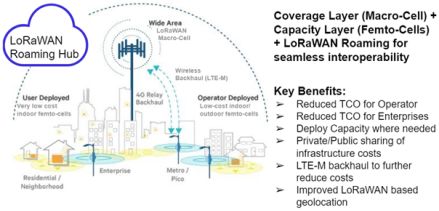
Image Source: Actility
LoRaWAN provides horizontal connectivity solutions to meet the broad needs of LPWAN deployments for IoT applications. However, only proprietary smart network server algorithms from network solution providers can realize these advantages.
▼ Previous Highlights▼ Key Considerations for Enterprises in Edge Computing Autonomous Driving Means the Rise of the Passenger Economy! How IoT Companies Face Security Policy Regulation Behind Google’s Fine Sharing Perspectives | IoT Data Needs Sharing Protocol In the Era of IoT, Why Edge Computing Becomes Important and Different
Must-See for IoT Exhibitors at IOTE 2019!
Founded in 2009, covering 70,000 square meters, the world’s first exhibition, an industry barometer!
Exhibition Inquiry: Mr. Chen 18676385933 (WeChat same number)
